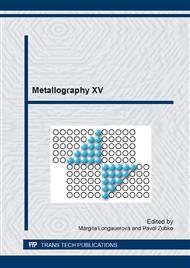[1]
G.R. Cowan, O.R. Bergmann, A.H. Holzmann, Mechanism of bond zone wave formation in explosion-clad metals, Mater. Trans. 2 (1971) 3145-3155.
DOI: 10.1007/bf02814967
Google Scholar
[2]
J. Song, A. Kostka, M. Veehmayer, D. Raabe, Hierarchical microstructure of explosive joins: Example of titanium to steel cladding, Mat. Sci. Eng. A528 (2011) 2641-2647.
DOI: 10.1016/j.msea.2010.11.092
Google Scholar
[3]
S.A.A. AkbariMousavi, P. Farhadi, S. Dartangi, Experimental investigation of explosive welding of cp-titanium/AISI 304 stainless steel, Mater. Des. 30 (2009) 459-468.
DOI: 10.1016/j.matdes.2008.06.016
Google Scholar
[4]
R. Kaçar, M. Acarer, Microstructure–property relationship in explosively welded duplex stainless steel-steel, Mater. Sci. Eng. A363 (2003) 290-296.
DOI: 10.1016/s0921-5093(03)00643-9
Google Scholar
[5]
N.V. Rao, D.S. Sarma, S. Nagarjuna, G. Madhusudhan, Influence of hot rolling and heat treatmenton structure and properties of HSLA steel explosively clad with austenitic stainless steel, Mater. Sci. Technol. 25 (2009) 1389-1396.
DOI: 10.1179/174328408x382208
Google Scholar
[6]
D. Ostroushko, E. Mazancová, Selected properties of stainless steel-titanium sandwich after explosive welding, in: A.D. Deribas, Ju.B. Scheck (Eds. ), Explosive Production of New Materials, Moscow, 2012, pp.84-86.
Google Scholar
[7]
M. Yadegari, A.R. Ebrahimi, A. Karami, Effect of heat treatment on interface microstructure and bond strength in explosively welded Ti/304L stainless steel clad, Mater. Sci. Technol. 29 (2013) 69-75.
DOI: 10.1179/1743284712y.0000000099
Google Scholar
[8]
K. Lublińska, A. Szummer, M. Gloc, K. Szpila, K.L. Kurzydlowski, Effect of hydrogen on degradation of explosion welded clad steels, ActaMetallurgicaSlovaca 13 (2007) 508-511.
Google Scholar
[9]
E. Mazancová, D. Ostroushko, M. Subíková, Study of hydrogen induced cracking of steel welded with titanium, Metallic J. 64 (2011) 26-29.
Google Scholar
[10]
H.G. Nelson, Hydrogen embrittlement, Mater. Sci. Technol. 25 (1983) 275-359.
Google Scholar
[11]
NACE Standard TM 0284-2011, item No. 21215, Evaluation of pipeline and pressure vessels for resistance to hydrogen induced cracking, NACE, Houston (2011).
Google Scholar
[12]
S. Ju. Mironov, G.A. Salishczev, Influence of grain size and micro-structure homogeneity on the deformation uniformity of commertiallypure titanium (in Russian), Fiz. Metall. i Metallovedenie 92 (2001) 81-88.
Google Scholar
[13]
T. Margin, J.H. Driver, The influence of strain rate on the low cycle fatigue properties of single crystals and polycrystals of two ferritic alloys, Mater. Sci. Eng. A39 (1979) 175-185.
DOI: 10.1016/0025-5416(79)90057-0
Google Scholar


